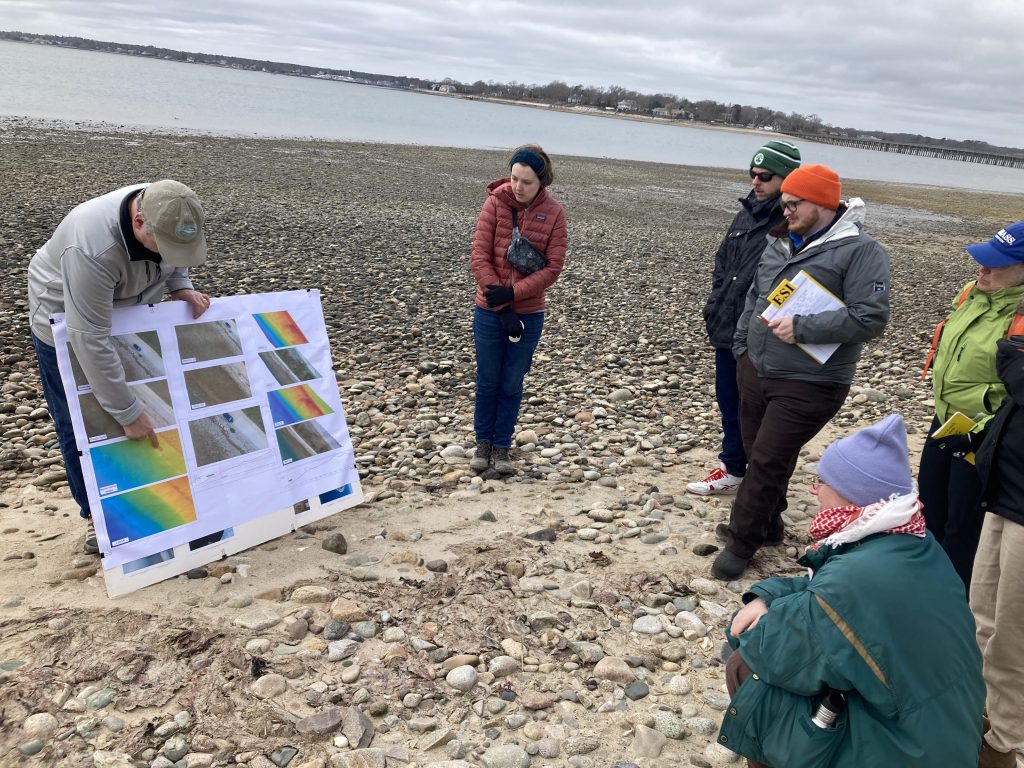That’s a Wrap! Cobble Berms Education and Outreach Pilot


June 2024 marked two years since the Lab’s cobble berms research, monitoring, and education project began. Over the course of the project thus far, staff from the Stone Living Lab, Duxbury Beach Reservation, and Woods Hole Group have led research, monitoring, and education efforts at cobble berm sites across coastal Massachusetts. The project has been supported by various funding sources, including a MA CZM Coastal Resilience grant.
Led by input from focus groups and our first year of field courses, the cobble berm project team put together three education programs in Spring 2024: two field courses and a virtual permitting workshop. Almost 200 individuals and over 85 unique organizations have engaged with our programming for this project. From recent graduates to seasoned municipal leaders, this program has connected practitioners and enhanced local understanding of cobble berms as a coastal resilience strategy.

Throughout our programming, there have been consistent themes and questions about cobble berms that come up again and again from attendees: How much do they cost? Where do you source cobbles from? What is the permitting process? And, perhaps most importantly: How do they work?

In-field and in-person experiences are crucial to build connections and familiarity between people and field strategies – but this project also focuses on creating resources that will support the coastal community beyond this individual project. Using input from attendees and MA CZM itself, the project team also created factsheets, videos (available soon), a coastal professionals listserv, and an interactive Storymap to support ongoing learning and research.
Supported by the efforts of the project team’s researchers from Woods Hole Group and the Stone Living Lab, this program has amplified cobble berms as an effective nature-based approach for coastal communities. Rather than falling back on familiar gray infrastructure strategies, municipal staff are becoming more familiar with nature-based approaches as a whole. By highlighting the scientific backing of cobble berms, creating space for in-person discussions, and creating user-friendly outreach materials, we have already seen a shift in public perception of cobble berms as an effective means of coastal resilience.
While the CZM Coastal Resilience grant was for two years and is now wrapping up, the work on this project is continuing, of course! Researchers with the Lab will continue to support monitoring efforts at a number of cobble berm sites, and SLL educators now have a jumping-off point to create even more factsheets, videos, and public events centered on this and other nature-based approaches.
We are deeply grateful to the many individuals who made this work possible: Julia Knisel and Rebecca Haney (MA CZM); Joey Negreann, Brynna McGlathery, and Cris Luttazzi (DBR); Kirk Bosma, Adam Finkle, Stuart Dak, Alex Carbone, Leslie Fields, Conor Ofsthun, Chris Gloniger, Brittany Hoffnagle, Annie O’Connell (WHG); Chris Krahforst and Brian DeFelice (Hull); Mark Borrelli, Kali Roberts, Jarrett Byrnes, Curtis Morris, Ingrid Comella, Colette Carter, Madison Lin, Amy Jones, Laura Dissly, Bob Chen, Paul Kirshen, and Chris Sweeney (UMB); Marc Albert (NPS); Rebecca Shoer, Brittany Knotts, Joe Christo (SLL); and our focus group members: Rachel Kelly, Kelly Phelan, Kate Kennedy, Chuck Shade, John Lopez, Chris Krahforst, Richard Vacca, Kara Shemeth, Michele Paul, Andrew McManus, David Gould Plymouth, Kevin Cafferty, Vince Murphy, and Russell Hopping.
Permitting Cobble Berms recording
Factsheet: Introduction to Cobble Berms
Factsheet: Top Ten Considerations
Factsheet: How Shorelines Behave
Blog: Cobble Berms Project Kickoff
Blog: Year One Update